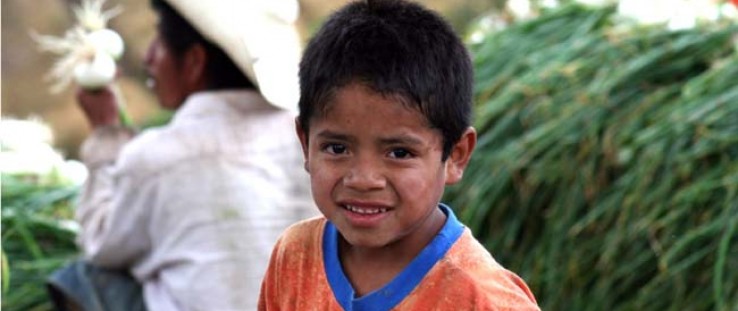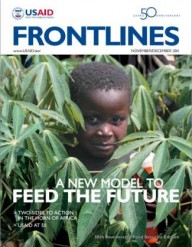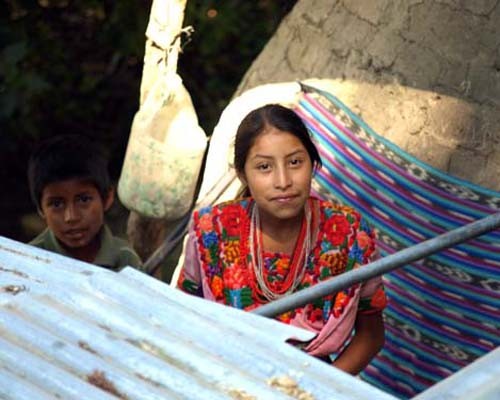 A boy helps his father prepare the onion harvest for market in Sololá in the Western Highlands region of Guatemala.
CREDIT: ALFREDO CALDERÓN, USAID
A boy helps his father prepare the onion harvest for market in Sololá in the Western Highlands region of Guatemala.
CREDIT: ALFREDO CALDERÓN, USAID
 A boy helps his father prepare the onion harvest for market in Sololá in the Western Highlands region of Guatemala.
CREDIT: ALFREDO CALDERÓN, USAID
A boy helps his father prepare the onion harvest for market in Sololá in the Western Highlands region of Guatemala.
CREDIT: ALFREDO CALDERÓN, USAID
The soil is fertile and the people have been farming it for generations. The climate is right for several growing seasons of corn, wheat, beans, and myriad other crops. Why then does Guatemala have more chronically malnourished children than any other country in the Western Hemisphere, ranking sixth among nations globally for this human development indicator?
Food insecurity is not only a barrier to development in Guatemala—it has direct implications for neighbors in Central America and, ultimately, points north.
Guatemala’s crisis has been the subject of international press in the last couple of years—finally, the world is learning that one out of every two Guatemalan children younger than 5 years old is chronically malnourished. The national data mask an even worse situation among indigenous populations (mostly Maya people) where malnutrition stunts the growth of 65.9 percent of indigenous children ages 3 months to 59 months, compared with only 36.9 percent among non-indigenous children.
In Guatemala, leaders are just beginning to see how this situation holds everyone back, not just the malnourished and the poor who make up 51 percent of the population. Kevin Kelly, USAID/Guatemala mission director, explains: “Public awareness is growing that high levels of chronic malnutrition have far-reaching repercussions, including poverty and crippled economies that result in large numbers of disenfranchised youth migrating or engaging in criminal activities.”
How does this happen? Malnutrition stymies cognitive and physiological growth in the first 1,000 days of life—from a mother’s pregnancy through her child’s second year of life. This irreversible stunting dooms children to repetitive illness, inhibits them intellectually and physically, and ultimately reduces their productivity as adults by roughly a third. For society, this adds up to a dire scenario: Results from a recent UNICEF study show that chronic malnutrition costs Guatemala $8.4 million each day in reduced productivity, hospitalization, student failure, and repetition in the first three years of primary school.
Crisis Cross-Pollination
In an increasingly globalized world, one country’s crisis quickly penetrates the borders of another. “When large numbers of people in a society cannot meet their basic needs, the situation evolves to political instability, social conflict, and violence as Guatemala’s neighbors, trading partners, tourists, and citizens are discovering,” says Casey de Vides, USAID/Guatemala democracy and governance adviser. Since 2008, each year nearly 30,000 Guatemalans who have migrated north to look for work have been deported by the United States, according to Guatemalan Government migration statistics.
The country counts itself an important U.S. trading partner, with ties that stretch back to the early 1800s during the Jefferson era. Speaking before Congress last February, Mark Feierstein, USAID assistant administrator for the Bureau for Latin America and the Caribbean, highlighted the connection: “We help each other not only because it is the right thing to do and is an expression of our [American] values, but because our well-being is linked to that of people throughout this vast and diverse hemisphere.”
While undernutrition is widely recognized in other parts of the world, Guatemala’s crisis went relatively unnoticed until international media began to expose the direct connection between the sharp rise in chronic hunger and malnutrition, the world economic crisis, and global climate change. In the case of Guatemala, this means floods and droughts exacerbated by severe deforestation. The international coverage brought the high prevalence of undernutrition to the attention of Guatemala’s opinion leaders, development organizations, and informed citizens. But to those most affected, chronic malnutrition is just part of life. Among the rural poor, who are mostly indigenous, mothers and fathers and community leaders will tell you: ’We’ve always eaten frijol and tortillas, and drunk coffee. Babies get sick and mothers die in childbirth—it has always been this way.’
“It’s also been elusive to Guatemalan economic and political leaders who are just beginning to understand how the ’other half’ of our nation—rural, indigenous, and marginal urban populations—lives, and that Mayans [Guatemala’s majority indigenous population] are not genetically short in stature,” reflects Dr. Baudilio López, USAID/Guatemala health officer. For development leaders, chronic malnutrition is usually considered another ingredient in a statistic stew along with natural disasters, rapid population growth, a faltering economy, increased crime, maternal and infant mortality, urbanization, and poverty.
So how did chronic malnutrition come to be invisible? History holds part of the answer: Guatemala is a post-conflict society that emerged from a 36-year civil war in December 1996—a war that shredded the delicate fabric of an already divided society—and a recent democracy that adopted its current constitution in 1985.
It is the land of the ancient Maya who still wear traditional clothing and speak 22 indigenous languages. When the Spanish conquered the Maya 500 years ago, they retreated to the hills and mountains to avoid the injustices of colonization. In the highlands, they built communities with market and political systems that were insulated from central government and mainstream commerce and social life. They followed their ancestors’ slash-and-burn practices to cultivate beans and corn, and they became migrants working on non-native coffee, banana, and sugar plantations.
Basic services, such as electricity, water and sanitation, health and education, and new technologies like agricultural diversity and cultivation practices did not reach the isolated communities. The civil war further severed relations between the disenfranchised rural indigenous and the urban, largely Ladino (non-indigenous and officially recognized as a distinct ethnic group) landowners and government leaders.
Another part of the equation is that chronic malnutrition was never identified as a root cause of other development challenges.
Feeding for a Stable and Secure Future
The average citizen in the United States spends approximately 10 percent of family income on food while the poorest of the world spend over 50 percent. Improving nutrition in developing countries, and particularly during the critical 1,000-day window beginning with a woman’s pregnancy through her child’s second birthday, has long-lasting positive effects and can help break the cycle of poverty. Strong evidence demonstrates that providing better nutrition within that window could save millions of lives and increase a country’s gross domestic product by at least 2 to 3 percent annually.
Guatemala has 14 eco-regions with climate and soils that produce an abundance of food. However, the basic diet among the rural poor, who are mostly indigenous, is beans (frijol), corn in the form of tortillas or broths, and coffee with little use of fruits, vegetables, or sources of animal-based protein. This derives from a history and culture of subsistence farming using slash and burn techniques. Even communities that produce crops such as carrots, onions, strawberries, or squash prefer to sell the produce rather than consume it. They are often not aware that their produce is any more nutritious than that in their regular diet.
Unlike other countries where malnutrition is largely a problem of availability, the malnutrition situation in Guatemala stems from people, particularly women’s lack of access to the money needed to buy nourishing food, and the improper use of food. In the book, Finding the Ties that Bind: Beyond Headship and Household, the Population Council’s Judith Bruce and Cynthia Lloyd explain how in Guatemala, an additional $11.40 per month in a mother’s hands would achieve the same weight gain in a young child as an additional $166 earned by the father.
Growing Opportunity
There are significant opportunities to simultaneously increase the income and nutritional status of rural households and increase the efficiency of poverty-fighting municipal services. One of the most promising opportunities is Guatemala’s leader status in non-traditional agriculture, horticulture, and coffee exports in Central America. For example, USAID programs have engaged thousands of small-scale coffee growers in the highlands to develop production and marketing skills and participate in a global market niche for high-quality, specialty coffees. Guatemalan coffee production creates 2 million jobs every year for rural families.
Recognizing the opportunities and challenges, in 2010, USAID realigned its resources to focus on reducing malnutrition as the root cause of poverty—which drives people to seek work in other countries or with the growing drug or human-trafficking trades.
The new presidential initiatives, Feed the Future and Global Health, are timely for Guatemala; they facilitated the design of a multi-year, multi-sector strategy for food security and nutrition in support of the Government of Guatemala’s inclusive country-led food security plan.
The USAID strategy focuses on the poor, food-insecure Western Highlands region. It is embraced by a wide-range of Guatemalan stakeholders including national government officials, municipal authorities, private sector leaders, rural poor community leaders and families, civil society organizations, and other international donors, who have not historically sat around the same planning table.
“The goal,” says David Delgado, senior food security adviser for USAID/Guatemala, “is to sustainably reduce poverty and chronic malnutrition in Guatemala by focusing on agriculture, local governance, and nutrition.”
Horticulture and coffee hold the strongest potential for small-scale farmers and cooperatives where lands are managed and worked collectively and the proceeds are shared. Linking health and nutrition education interventions, particularly with mothers and small children, with agriculture value chains, and incorporating the support of municipal leaders is vital for the sustainability of this ambitious development venture.
The Feed the Future Foundation
Based on USAID best practices, this is how it is expected to work: Feed the Future will strengthen municipal governments’ economic development plans to reduce poverty and chronic malnutrition, improve their capacity to deliver basic services, especially water and sanitation, and support community-based advocacy to ensure that food security is sustainable. USAID will continue support to NGOs that advocate for improved health and nutrition, and is working to ensure that local governments are accountable and responsive to the needs of vulnerable groups. “Our experience shows that increased income for farmers and job creation for day laborers that comes from the production of high-value crops, complemented by better access to basic health services, nutrition education, potable water, and comprehensive hygiene, improves food security and offers rural families a ticket out of poverty,” says Julia María Asturias, USAID/Guatemala food security officer. Targeted environmental and climate change-mitigation activities will further reduce food insecurity.
The strategy aligns USAID resources and integrates programming with other U.S. Government agencies; leverages investments from other donors, the private sector, and the Government of Guatemala; and includes an active monitoring and evaluation component and a diplomatic strategy to advocate for policy changes that increase the likelihood of sustainable poverty reduction in Guatemala.
“In short,” continues David Delgado, “our strategy takes a wide angle-lens view of what causes chronic malnutrition and concentrates our joint efforts on one geographic area, always in partnership with Guatemalan Government and community leaders. It is strategic to build on synergies between the USAID Feed the Future and Global Health Initiatives so that we can offer the rural poor an integrated set of tested solutions. We will commence work with those people who are most affected and most likely to be change agents: women and small-scale farmers.
“We know that raising income to increase access to food and improving nutrition practices are the best ways to attack chronic malnutrition. To improve nutrition practice, behavior change in rural households is needed—from selection and cooking of nutritious foods to food allocation within the family and care giving. Because these are traditionally women’s responsibility, an active and more empowered role of women—wives, mothers, mothers-in-law, and grandmothers—is essential to reduce chronic malnutrition. Women must learn to increase essential vitamins and minerals in the family diet, they must practice immediate and exclusive breastfeeding of newborns and learn complementary feeding of young children as well as the prevention and early detection and treatment of childhood illnesses.”
The change in women’s role and behavior will be sustainable if it is supported by male community leaders and family members. Local governance is an effective way to engage men in behavior change around nutritional choices and the use of scarce financial resources for nutrition during the first 1,000 days during a woman’s pregnancy and her child’s second birthday. An Uphill Climb
There is far to go before chronic nutrition stops stunting half of Guatemala’s future. But raising public awareness of the problem and making its profound and far-reaching effects visible comes at a strategic time for Guatemala and its neighbors, providing an opportunity for new partners to work in innovative ways toward mutual prosperity, security, and stability.
Felix Mayor, leader of the Utz-Ajticonelá association in Zaragoza, Chimaltenango, reflects on the changes that USAID/Mercy Corps-led agriculture value chains have brought his community: “When our land is healthy, then our people are healthy and can grow up strong like our crops to feed us so that we can work; then we thrive. When we thrive, our youth stay home….
“Now we have a high school so they can work and go to school and stay here with the family. When the technicians first came to offer to help us learn to diversify our crops our land was sick—our strawberries no longer grew as they used to and we suffered—we did not know what to do. The technicians taught us how to take care of our environment, plant new crops, and nourish the soil with rotating these new plants with our strawberries. We learned to recycle our plastic, to build latrines, and to fence in our collective plots.
“Our women now work in the new packing plants. Not only do they have incomes for the first time in our history, they learn hygiene and to use the crops we produce for family meals. We no longer have to sell to the coyotes on the side of the main roads. Now we sell with dignity to buyers who pay us a fair price that we learned how to negotiate. We earn more. So, like the land, with opportunities we can thrive and take better care of our children and our community.”
Food security
A farmer from Sololá shows his snow peas fresh from the vine. Snow peas are a non-traditional export that Guatemala began producing with USAID agriculture value chain alliances.
Food security is composed of three elements: Food access is adequate resources to obtain appropriate foods for a nutritious diet, which depends on income available to the household, the distribution of income within the household, and the price of food. Food utilization is proper biological use of food, requiring a diet providing sufficient energy and essential nutrients, potable water, and adequate sanitation as well as household knowledge of food storage and processing, the basic principles of nutrition, and proper management of childcare and illness. Food availability is having sufficient quantities of food available from household production, other domestic output, commercial imports, or food assistance.











Comment
Make a general inquiry or suggest an improvement.